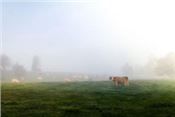Green Grass Can Fool Cattle Producers

The first green grass of spring might not be the most nutritious for cattle.
Photo by Aimee Nielson
LEXINGTON, KY.
Spring is on the horizon. Most cattle producers are ready to put the cold and snow behind them and see the pastures greening up. But University of Kentucky beef specialist Katie VanValin urges producers not to let the green grass fool them.
“The growth we see in our pastures in the early spring can be deceiving,” she said. “From a nutrient standpoint, it often just won’t cut it. There’s just not yet enough forage available, and what is available has a high moisture content. When we turn the cows out too early, they can exert more energy searching for the next bite, and most of that mouthful ends up being water.”
For spring-calving cows, this time is especially critical. Most cows are transitioning from late gestation to lactation right now, and their nutrient requirements are at their highest. VanValin said it’s not a time to let cows slip into an energy deficit and lose body condition. She encourages producers to make sure cows are in good body condition before calving and then maintain their condition through breeding to ensure optimum performance.
“Research shows us that cows reproductive performance begins to decline when cows reach a body condition score of 4, so it’s crucial to performance and efficiency of the herd for cows to maintain a body condition score of 5 to 6,” VanValin said.
If producers turn cows out too early, it can also cause undue stress on forages, ultimately hurting the stand and creating an opportunity for weeds to invade. Instead, producers need to evaluate the forages in their pasture and let the grass growth dictate when to turn cows out as opposed to a date on the calendar.
Another problem of early green pastures is “grass tetany”. Grass tetany most often occurs in older, lactating cows consuming a diet of lush green grass that is high in potassium and low in magnesium. It may also occur in cows with insufficient forage available and consequently have an insufficient intake of magnesium.
“While grass tetany commonly occurs in early spring, we also see it when feeding wheat or rye baleage, since the cereal grains are usually high in potassium and nitrogen but low in magnesium,” said UK College of Agriculture, Food and Environment ruminant veterinarian Michelle Arnold. “In any case, affected cattle have borderline low blood magnesium concentration, and then they develop clinical signs of grass tetany when triggered by a stressor such a cold snap.”
Producers can prevent it by feeding a magnesium supplement during times when conditions are right for grass tetany to occur.
“Ideally, producers will begin to supplement with free-choice, high- magnesium mineral at least 30 days prior to calving,” Arnold added.
If cattle show signs of grass tetany, Arnold emphasized it is a true veterinary emergency, and they need prompt treatment. Producers should be very careful around cattle suspected of having grass tetany, as they may be quite aggressive. Prevention of this condition is much better than a cure, because survival rates are low, around 40 percent of affected cattle. Soil testing is always a good indicator of pasture potassium levels.
“The bottom line here is, don’t let spring fever set in early and turn your cows out on a pasture that doesn’t meet all the nutritional needs of your herd,” VanValin said. “Continue to evaluate body condition score and let that guide your management decisions during the transition to spring.” ∆